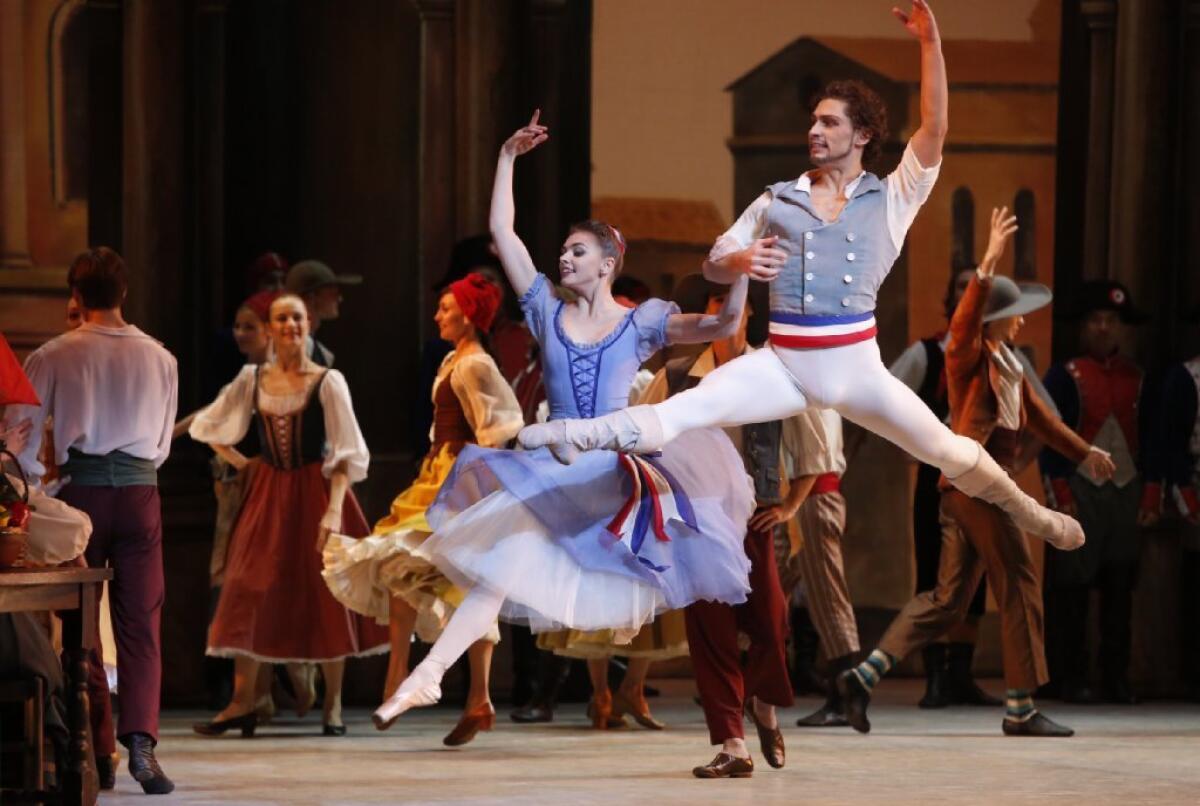Review: Mikhailovsky Ballet’s ‘Flames of Paris’ makes rousing West Coast debut

- Share via
From our 21st century vantage, Mikhailovsky Ballet’s “The Flames of Paris” is a crazy quilt of cultural references — a rousing Soviet-style story ballet about the French revolution, created to celebrate the 15th anniversary of the Bolshevik takedown of the czar, and now revised to pristine condition by a legendary Russian ballet master who defected to the West in 1980.
It’s head-spinning. But the St. Petersburg-based Mikhailovsky, which was presented with its orchestra at the Segerstrom Center for the Arts over the weekend, performs this three-act work with sparkle and clear focus.
This was a belated premiere for both the company and the full-length “Flames of Paris” (created in 1932, this staging from 2013). It was one of those rare moments when a piece that might qualify as a warhorse was treated by its performers as a precious vehicle for gorgeous dancing.
The Mikhailovsky is an old theater (built in 1833), but a young company; two-thirds of its 140 dancers (112 on this tour) were hired by ballet master Mikhail Messerer, who took over the troupe in 2009.
They do not possess the flawless delivery of their more well-known and much larger Russian competitors, the Mariinsky and Bolshoi ballets. But they make up for that with individuality and spunk. The occasional wobbles didn’t matter.
“Flames” takes place in August 1792, when the French populace rose up and attacked the Tuileries Palace, ending the reign of Louis XVI. Choreographer Vasily Vaynonen and composer Boris Asafiev paint this history in black and white — a corrupt court and a pure public. This was an allegory made in the time of Stalin, who reportedly greatly favored it.
But it is also a contemporary crowd-pleaser, no matter your political persuasion, and one that is nevertheless complex in the depth of its choreography, and even crystalline in its passages of classical dancing.
The nobles with their tall white wigs graciously strut, dancing the minuet with a lazy, aristocratic bearing. Then there are the crowds that rock and sway through rambunctious folk dances, including an infectious clogging number and a foot-stomping, heart-pounding, gypsy-like piece.
In an entirely different style epitomizing the grand Soviet artists, the allegorical dance “Freedom” featured strongman Marat Shemiunov repeatedly holding the fearless Irina Perren over his head with one hand, while he wore a sheepish, sweet smile.
The court entertainers moved with precise, 19th century classical styling. The women in the corps de ballet bent delicately at the waist and crimped their arms, reminding one of figures on Wedgewood pottery. The men’s dancing was unstrained, with beats cleanly executed.
Then there is the sheer heroic quality of “Flames” and for that we had cheerleader Ivan Vasiliev. Portraying Philippe the Marseillais, Vasiliev was his thrilling, charismatic self, with sky-high leaps and perfectly timed pirouettes that ended facing the audience, with him balanced on demi-point. He is a mass of unrestrained energy.
He stayed in character for the first two acts, but gave in to the applause and roars of approval by the ballet’s end, at which point he started portraying, well, himself: Vasiliev the wunderkind.
We watched his chest heave from the exertion as he pushed himself to extremes and no longer cared if we knew it — at some point he landed too hard on his knee, which bled through his tights. Here’s hoping he grows out of these habits.
In contrast, Oksana Bondareva was full of charming grace and humbleness as Jeanne, the peasant girl. A refined performer, her solid point work was consistently airy -- that contradiction so difficult to master.
The ballet’s jumps and turns on one leg were an easy trial, too, for Irina Perren, who portrayed Diana the actress. Victor Lebedev, as Antoine the actor, was a self-assured soloist with a fine line, but he was a little rocky as a partner. Veronika Ignatyeva made a dainty Cupid, while Mariam Ugrekhelidze whipped herself into a frenzy as Teresa the Basque.
Conductor Pavel Bubelnikov kept the expressive musicians in perfect sync with the dancers, so that the score and performer reinforced one another. This musical partnership, the way you can feel the rhythmic pulse of the Russian dancers, is another treat that the Mikhailovsky bestowed on us.
The final performance of the Mikhailovsky Ballet and Orchestra’s “The Flames of Paris” is Sunday at 2 p.m. at the Segerstrom Center for the Arts.
More to Read
The biggest entertainment stories
Get our big stories about Hollywood, film, television, music, arts, culture and more right in your inbox as soon as they publish.
You may occasionally receive promotional content from the Los Angeles Times.










